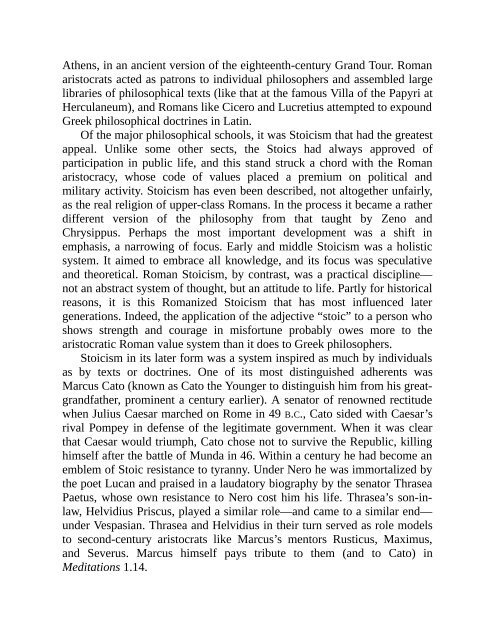9781945186240
Create successful ePaper yourself
Turn your PDF publications into a flip-book with our unique Google optimized e-Paper software.
Athens, in an ancient version of the eighteenth-century Grand Tour. Roman<br />
aristocrats acted as patrons to individual philosophers and assembled large<br />
libraries of philosophical texts (like that at the famous Villa of the Papyri at<br />
Herculaneum), and Romans like Cicero and Lucretius attempted to expound<br />
Greek philosophical doctrines in Latin.<br />
Of the major philosophical schools, it was Stoicism that had the greatest<br />
appeal. Unlike some other sects, the Stoics had always approved of<br />
participation in public life, and this stand struck a chord with the Roman<br />
aristocracy, whose code of values placed a premium on political and<br />
military activity. Stoicism has even been described, not altogether unfairly,<br />
as the real religion of upper-class Romans. In the process it became a rather<br />
different version of the philosophy from that taught by Zeno and<br />
Chrysippus. Perhaps the most important development was a shift in<br />
emphasis, a narrowing of focus. Early and middle Stoicism was a holistic<br />
system. It aimed to embrace all knowledge, and its focus was speculative<br />
and theoretical. Roman Stoicism, by contrast, was a practical discipline—<br />
not an abstract system of thought, but an attitude to life. Partly for historical<br />
reasons, it is this Romanized Stoicism that has most influenced later<br />
generations. Indeed, the application of the adjective “stoic” to a person who<br />
shows strength and courage in misfortune probably owes more to the<br />
aristocratic Roman value system than it does to Greek philosophers.<br />
Stoicism in its later form was a system inspired as much by individuals<br />
as by texts or doctrines. One of its most distinguished adherents was<br />
Marcus Cato (known as Cato the Younger to distinguish him from his greatgrandfather,<br />
prominent a century earlier). A senator of renowned rectitude<br />
when Julius Caesar marched on Rome in 49 B.C., Cato sided with Caesar’s<br />
rival Pompey in defense of the legitimate government. When it was clear<br />
that Caesar would triumph, Cato chose not to survive the Republic, killing<br />
himself after the battle of Munda in 46. Within a century he had become an<br />
emblem of Stoic resistance to tyranny. Under Nero he was immortalized by<br />
the poet Lucan and praised in a laudatory biography by the senator Thrasea<br />
Paetus, whose own resistance to Nero cost him his life. Thrasea’s son-inlaw,<br />
Helvidius Priscus, played a similar role—and came to a similar end—<br />
under Vespasian. Thrasea and Helvidius in their turn served as role models<br />
to second-century aristocrats like Marcus’s mentors Rusticus, Maximus,<br />
and Severus. Marcus himself pays tribute to them (and to Cato) in<br />
Meditations 1.14.


